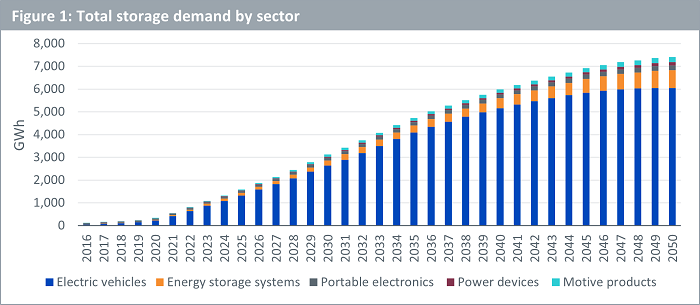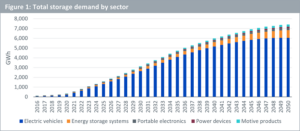We view electric vehicles (EVs) as machines requiring electrical power from the grid. We know that a large percentage of an EV’s cost, weight, volume, and complexity, lies in the battery. So, if the battery is the most prized component within an EV, can it be used in a better way? Vehicle-to-grid technology (V2G) allows us to treat EVs like batteries on wheels. Instead of the vehicle only taking power from the grid, V2G enables it to also give power back to the grid and create what is referred to as ‘bidirectional charging’.
Why it makes sense
The International Energy Agency (IEA) has stated that, in a net zero scenario, the world’s battery storage capacity needs to rise 17x by 2030 compared to 20201. What the IEA doesn’t specify is whether the storage must be stationary or mobile. Stationary capacity, in the form of large energy storage systems, is expanding quickly but its growth pales in comparison to the battery growth expected to be driven by electric vehicles (see Figure 1 below). It, therefore, makes sense to utilise the most rapidly growing form of energy storage better.

Source: WisdomTree, Wood Mackenzie, forecasts from 2023.
Forecasts are not an indicator of future performance and any investments are subject to risks and uncertainties.
Energy storage is also likely to be most effective if it is well-distributed. The entire purpose of energy storage is to manage the intermittency of renewable energy. Well-distributed energy storage across the grid could help manage demand and supply better and reduce transmission losses. Electric vehicles, naturally, are distributed across the grid, since they are parked close to their owners.
Private cars generally sit parked around 95% of the time2. This means that, for 95% of the time, consumers pay for the convenience of having a car which they can drive for the remaining 5%. If, when it is not being driven, the car can be used as a store of energy, we could start making use of the car 100% of the time.
But why would a consumer do it?
Consumers who charge their EVs at home typically go for a variable tariff to charge cheaply during off-peak times. Not only is this cheaper for the consumer, it also helps manage the load on the grid. With bidirectional charging, they could charge at a cheap tariff during off-peak hours and give back to the grid during peak hours at a higher tariff. The car, on account of its battery, could potentially help the user generate revenue.
This approach could also create enormous savings when homeowners or businesses consider installing solar panels. The battery storage cost can be a meaningful part of total upfront costs of such systems. If the car can remove the need for another battery, it immediately creates a significant capital saving. When combined with solar technology in this way, it becomes even more appealing as the consumer could be generating their own energy and selling to the grid during peak hours at the most attractive tariff.
What about battery life? Admittedly, battery depletion depends on several factors. Among the factors is how often the charge level reaches either extreme (that is, fully charged or fully discharged). EV manufacturers often recommend charging to no more than 80%. It is also advisable to not let charge drop too low to preserve battery life and, of course, to not risk getting stranded on the road. A 2017 University of Warwick study3 found that utilising an EV battery in a V2G scenario does not necessarily harm its performance – it may even increase it. So, while more research is required to conclusively determine the impact of V2G on battery life, there are ways to run the process optimally to maximise longevity.
What has AI got to do with it?
AI can help optimise the timing and magnitude of energy transfer between the vehicle and the grid. When should the consumer charge, when should they retain charge, and when should they give back to the grid? This optimisation would consider user consumption patterns so there is always sufficient charge in the battery for the road journeys and any excess is sold back to the grid. AI systems can also monitor and predict the health and performance of the battery encouraging proactive maintenance to ensure the longevity and reliability of batteries.
From the grid’s perspective, V2G adds another variable to consider in addition to things like weather patterns which determine power generation from renewables. In this case, user consumption patterns will need to be predicted to better manage demand and supply. Today, grid operators must match reasonably predictable demand patterns with supply. Once consumers become part of the supply mix, predicting supply will become harder, making the role of AI systems more important.
Is this all just science fiction?
It isn’t. As with many things, regulation plays a crucial role. The state of California, which is aggressively looking to reduce carbon emissions, and last year prohibited the sale of internal combustion engine cars from 2035, is pondering over a bill filed in the state legislature that would mandate that every EV sold in California have V2G capability build in. This means that V2G is already attracting the attention of policymakers. This is an encouraging sign as it could encourage more progress on overcoming any regulatory hurdles before EV owners start selling energy to the grid.
Several automakers have already introduced EV models capable of bidirectional charging (for example, the Nissan Leaf, Ford F150 and Kia EV6). Until it becomes widely adopted, V2G could be a way for automakers to gain a competitive advantage. Given most automakers have now worked out how to manufacture an EV, they have more bandwidth to figure out this next engineering challenge, which many claim won’t be too difficult.
Nissan is already in partnership with Eon to promote the use of V2G technology. Eon’s white paper on the topic makes a more detailed case on this.
The way forward for investors
At WisdomTree, we believe V2G is an exciting emerging technology within the battery value chain. EVs, their batteries, and the ecosystem they operate within, promise exciting innovations and lots of change in the way we power our cars, homes, and lives. For investors, a diversified approach across the battery value chain could be a way to gain exposure to a broad set of opportunities. This includes incumbent technologies of today, such as lithium-ion battery manufacturing, as well as emerging technologies like V2G and others.
Sources
1 International Energy Agency, 2022.
2 Based on the Massachusetts Institute of Technology’s ‘Unparking’ project 2020.
3 https://wrap.warwick.ac.uk/88018/
—
Originally Posted July 27, 2023 – How AI could turn electric vehicles into money-making machines
Disclosure: WisdomTree Europe
This material is prepared by WisdomTree and its affiliates and is not intended to be relied upon as a forecast, research or investment advice, and is not a recommendation, offer or solicitation to buy or sell any securities or to adopt any investment strategy. The opinions expressed are as of the date of production and may change as subsequent conditions vary. The information and opinions contained in this material are derived from proprietary and non-proprietary sources. As such, no warranty of accuracy or reliability is given and no responsibility arising in any other way for errors and omissions (including responsibility to any person by reason of negligence) is accepted by WisdomTree, nor any affiliate, nor any of their officers, employees or agents. Reliance upon information in this material is at the sole discretion of the reader. Past performance is not a reliable indicator of future performance.
Please click here for our full disclaimer.
Jurisdictions in the European Economic Area (“EEA”): This content has been provided by WisdomTree Ireland Limited, which is authorised and regulated by the Central Bank of Ireland.
Jurisdictions outside of the EEA: This content has been provided by WisdomTree UK Limited, which is authorised and regulated by the United Kingdom Financial Conduct Authority.
Disclosure: Interactive Brokers
Information posted on IBKR Campus that is provided by third-parties does NOT constitute a recommendation that you should contract for the services of that third party. Third-party participants who contribute to IBKR Campus are independent of Interactive Brokers and Interactive Brokers does not make any representations or warranties concerning the services offered, their past or future performance, or the accuracy of the information provided by the third party. Past performance is no guarantee of future results.
This material is from WisdomTree Europe and is being posted with its permission. The views expressed in this material are solely those of the author and/or WisdomTree Europe and Interactive Brokers is not endorsing or recommending any investment or trading discussed in the material. This material is not and should not be construed as an offer to buy or sell any security. It should not be construed as research or investment advice or a recommendation to buy, sell or hold any security or commodity. This material does not and is not intended to take into account the particular financial conditions, investment objectives or requirements of individual customers. Before acting on this material, you should consider whether it is suitable for your particular circumstances and, as necessary, seek professional advice.


























Join The Conversation
If you have a general question, it may already be covered in our FAQs. If you have an account-specific question or concern, please reach out to Client Services.